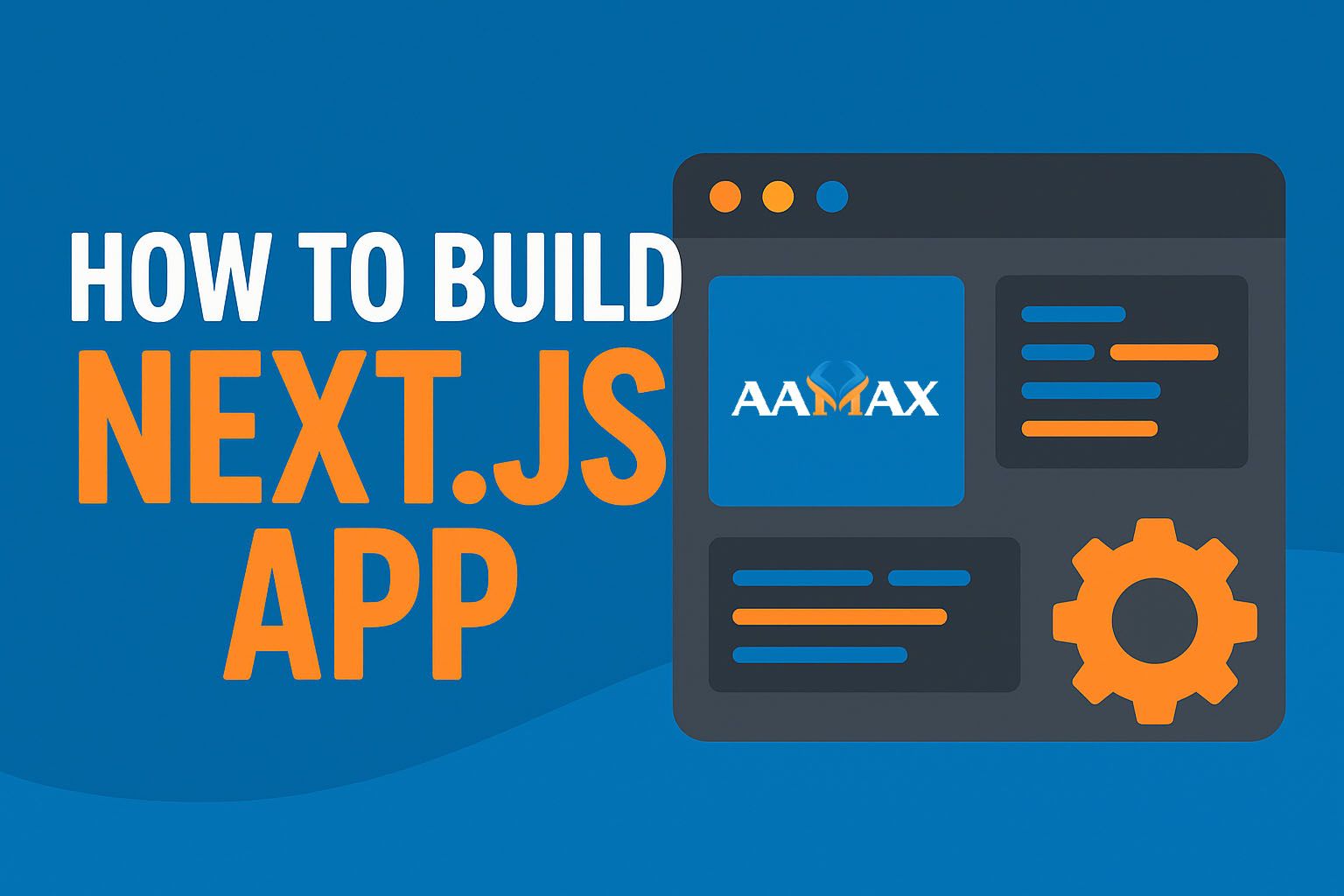
How To Build Next JS App
Building a web application with Next.js has become the go-to approach for developers who want to combine React's flexibility with server-side rendering (SSR) and static site generation (SSG) capabilities. Next.js simplifies complex React configurations and provides a production-ready environment for developing high-performance applications.
In this guide, we'll cover everything you need to know about how to build a Next.js app from scratch, including setting up the environment, understanding key concepts, integrating APIs, deploying your app, and following best practices. This article is ideal for beginners and developers looking to create scalable, fast, and SEO-friendly applications.
🚀 What Is Next.js?
Next.js is a React-based framework developed by Vercel that allows you to build server-rendered or statically generated websites and applications. It provides an optimized developer experience with automatic code splitting, file-based routing, and fast refresh features.
Key Benefits of Next.js
- Hybrid Rendering: Choose between SSR, SSG, ISR (Incremental Static Regeneration), or CSR.
- File-Based Routing: Every file in the
/pagesdirectory automatically becomes a route. - API Routes: Build backend endpoints directly within your app.
- Image Optimization: Automatically optimizes images for better performance.
- SEO-Friendly: Pre-rendered pages help your app rank better in search engines.
🧰 Setting Up Your Next.js Development Environment
Before we start building, make sure you have the following installed:
- Node.js (v16 or newer)
- npm or yarn package manager
- Code editor (like VS Code)
Step 1: Create a New Next.js App
You can create a Next.js app easily using the official CLI command:
npx create-next-app@latest my-nextjs-app
This command sets up a ready-to-use project with all dependencies installed.
Move into your project directory:
cd my-nextjs-app
Then, start your development server:
npm run dev
Open your browser and visit http://localhost:3000 --- your Next.js app
is now running!
🏗️ Understanding the Project Structure
When you open your project in VS Code, you'll see a structure like this:
my-nextjs-app/
├── pages/
│ ├── index.js
│ ├── _app.js
│ └── api/
│ └── hello.js
├── public/
├── styles/
├── package.json
└── next.config.js
Here's what each folder does:
- pages/ -- Contains all the page components and API routes.
- public/ -- For static assets like images and icons.
- styles/ -- Contains CSS modules and global styles.
- next.config.js -- Used for custom configurations.
- package.json -- Lists project dependencies and scripts.
📄 Creating Your First Page
Pages in Next.js are React components. Create a new file named
about.js inside the pages folder.
export default function About() {
return (
<div>
<h1>About Our Next.js App</h1>
<p>This page is rendered by Next.js using server-side rendering.</p>
</div>
);
}
Now visit http://localhost:3000/about --- you've created a new route
automatically!
This is the power of file-based routing in Next.js.
🧩 Working with Components
You can create reusable components in a new folder called /components.
Example: components/Header.js
export default function Header() {
return (
<header style={{ padding: "20px", backgroundColor: "#f8f8f8" }}>
<h2>My Next.js App</h2>
</header>
);
}
Then use it in your page:
import Header from "../components/Header";
export default function Home() {
return (
<>
<Header />
<main>
<h1>Welcome to Next.js</h1>
</main>
</>
);
}
🔁 Using Dynamic Routes
Next.js allows you to create dynamic routes for pages like blogs or user profiles.
Example: Create a file pages/blog/[id].js
import { useRouter } from "next/router";
export default function BlogPost() {
const router = useRouter();
const { id } = router.query;
return <h1>Blog Post ID: {id}</h1>;
}
Now visiting /blog/1 or /blog/hello-world will display different
content dynamically.
📦 Fetching Data in Next.js
Next.js supports multiple ways to fetch data depending on your needs.
1. Server-Side Rendering (SSR)
If you need fresh data on every request, use getServerSideProps.
export async function getServerSideProps() {
const res = await fetch("https://jsonplaceholder.typicode.com/posts/1");
const data = await res.json();
return { props: { post: data } };
}
export default function Post({ post }) {
return (
<div>
<h1>{post.title}</h1>
<p>{post.body}</p>
</div>
);
}
2. Static Site Generation (SSG)
If data doesn't change often, use getStaticProps for better performance.
export async function getStaticProps() {
const res = await fetch("https://jsonplaceholder.typicode.com/posts");
const posts = await res.json();
return { props: { posts } };
}
export default function Blog({ posts }) {
return (
<ul>
{posts.map(post => (
<li key={post.id}>{post.title}</li>
))}
</ul>
);
}
🔌 Adding API Routes
You can create server-side API routes directly inside the /pages/api
folder.
Example: pages/api/hello.js
export default function handler(req, res) {
res.status(200).json({ message: "Hello from Next.js API route!" });
}
Access it at http://localhost:3000/api/hello.
This is useful for handling form submissions, connecting to databases, or creating backend endpoints without needing a separate server.
🎨 Styling Your Next.js App
You can style your Next.js app in several ways:
- Global CSS -- Defined in
styles/globals.css. - CSS Modules -- Scoped to specific components (e.g.,
Home.module.css). - Styled JSX -- Built-in CSS-in-JS support.
- Tailwind CSS -- Popular utility-first framework.
Example using CSS Modules
Home.module.css
.title {
color: #44ce6f;
font-size: 2rem;
text-align: center;
}
Use it in your component:
import styles from "../styles/Home.module.css";
export default function Home() {
return <h1 className={styles.title}>Welcome to My Styled Next.js App</h1>;
}
🧠 Adding Environment Variables
Store your sensitive credentials (API keys, database URLs, etc.) in
.env.local:
NEXT_PUBLIC_API_URL=https://api.example.com
Then access it in your code:
const apiUrl = process.env.NEXT_PUBLIC_API_URL;
This keeps your secrets secure while allowing flexible configuration.
🔒 Authentication in Next.js
Authentication can be implemented using NextAuth.js, a library designed to work seamlessly with Next.js.
npm install next-auth
Then configure it in /pages/api/auth/[...nextauth].js:
import NextAuth from "next-auth";
import GitHubProvider from "next-auth/providers/github";
export default NextAuth({
providers: [
GitHubProvider({
clientId: process.env.GITHUB_ID,
clientSecret: process.env.GITHUB_SECRET,
}),
],
});
Now your app supports GitHub login in just a few lines of code!
🌍 Connecting a Database
For dynamic data, you can integrate MongoDB using Mongoose.
npm install mongoose
Create a file lib/dbConnect.js:
import mongoose from "mongoose";
const MONGODB_URI = process.env.MONGODB_URI;
async function dbConnect() {
if (mongoose.connection.readyState >= 1) return;
return mongoose.connect(MONGODB_URI);
}
export default dbConnect;
Then import it in your API route before handling data requests.
⚙️ Optimizing Your Next.js App for SEO
Next.js automatically provides many SEO advantages like server-side rendering and fast load times. You can also customize metadata for each page.
Use the <Head> component:
import Head from "next/head";
export default function Home() {
return (
<>
<Head>
<title>Next.js SEO Example</title>
<meta name="description" content="Learn how to build and optimize Next.js apps for SEO" />
</Head>
<h1>SEO-Optimized Page</h1>
</>
);
}
🚢 Deploying Your Next.js App
You can deploy your Next.js app easily on Vercel, Netlify, or AWS.
Deploying on Vercel
npm run build
vercel
Vercel automatically optimizes your app for production and handles serverless API routes.
💡 Best Practices for Building Next.js Apps
- Use TypeScript for type safety and scalability.\
- Optimize images using the
<Image>component.\ - Implement caching and ISR for faster page loads.\
- Follow SEO best practices for better rankings.\
- Split code for faster initial loads.\
- Keep your API logic modular for maintainability.\
- Use linting and Prettier for consistent code style.
🏆 Hire AAMAX for MERN Stack Development
If you're looking to build a Next.js application or want professional help with a full MERN stack project, consider partnering with AAMAX --- a full-service digital marketing and development company that offers:
- Web Development (MERN, Next.js, Node.js)
- Digital Marketing and SEO Services
- API Development and Integration
- Cloud and Deployment Solutions
AAMAX's team of experienced developers can help you build modern, scalable, and SEO-friendly web applications tailored to your business needs.
Visit AAMAX today to learn how their MERN stack development services can bring your ideas to life.
✅ Final Thoughts
Building a Next.js app is easier than ever thanks to its integrated features, flexible architecture, and production-ready tools. Whether you're a solo developer or a business looking to scale your digital presence, Next.js offers everything you need to create high-performance web applications.
By following this guide, you now know how to set up a Next.js project, create pages, fetch data, add APIs, manage authentication, and deploy your app. For professional-grade development, hiring experts like AAMAX ensures your Next.js project is built efficiently, optimized for SEO, and ready for success in the modern digital landscape.







